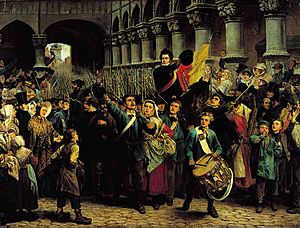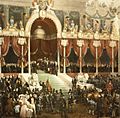Belgian Revolution facts for kids
Quick facts for kids The Belgian Revolution |
|||||||
|---|---|---|---|---|---|---|---|
 Charles Rogier leads the 250 revolutionary volunteers from Liège to Brussels (Charles Soubre, 1878) |
|||||||
|
|||||||
| Belligerents | |||||||
| Commanders and leaders | |||||||
| William I of the Netherlands | Erasme Louis Surlet de Chokier Charles Latour Rogier Étienne Maurice Gérard |
||||||
The Belgian Revolution was a major event where the southern parts of the United Kingdom of the Netherlands broke away. This led to the creation of an independent country called the Kingdom of Belgium.
Contents
The Belgian Revolution
Why the Revolution Started
The people in the southern areas of the United Kingdom of the Netherlands were mostly Roman Catholic. Many important people there also spoke French. They were not happy with King William I's rule. He was Protestant, and they felt he took away special rights from the Catholic Church.
The Uprising Begins
On August 25, 1830, trouble began in Brussels. Riots broke out, and some shops were looted. People who were watching an opera about freedom joined the rioters. The King then sent soldiers to try and stop the unrest.
The Fight for Independence
A major battle happened in Brussels. The French came to support the southern provinces that wanted to break away. Belgium won this battle and became an independent country.
A New Country is Born
In 1831, Leopold I became the first "King of the Belgians." It took until 1839 for the Dutch to officially agree that Belgium was independent. They signed a document called the Treaty of London.
Images for kids
-
The Netherlands, Belgium, Luxembourg and Limburg in 1839 1, 2 and 3 United Kingdom of the Netherlands (until 1830) 1 and 2 Kingdom of the Netherlands (after 1830) 2 Duchy of Limburg (1839–1867) (in the German Confederacy after 1839 as compensation for Waals-Luxemburg) 3 and 4 Kingdom of Belgium (after 1830) 4 and 5 Grand Duchy of Luxembourg (borders until 1830) 4 Province of Luxembourg (Waals-Luxemburg, to Belgium in 1839) 5 Grand Duchy of Luxembourg (German Luxemburg; borders after 1839) In blue, the borders of the German Confederation.
-
Leopold taking the constitutional oath (Gustaf Wappers, 1831)
-
Germany's defiance of the 1839 Treaty of London in 1914 outraged British opinion
See also
 In Spanish: Revolución belga para niños
In Spanish: Revolución belga para niños





